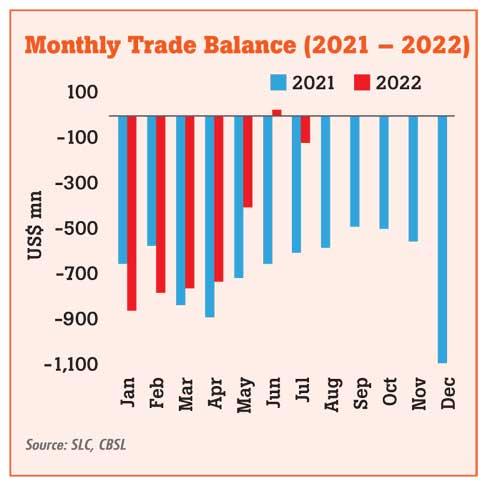Reply To:
Name - Reply Comment
After recording a trade surplus in two decades in June, the trade deficit in July narrowed significantly year-on-year
 |
(YoY) as imports contracted notably amid policy measures to discourage non-essential imports, while exports grew moderately.
The trade balance for July 2022 narrowed to US$ 123 million from US$ 606 million a year ago, while the cumulative deficit from January to July narrowed to US$ 3.6 billion from US$ 4.9 billion.
The worker remittance income for July, which stood at US$ 279 million—over 38 percent down YoY but slightly up from a month ago—remained in excess of the trade deficit, “thereby supporting forex liquidity conditions under severe balance of payment pressures,” the Central Bank said.
Exports earnings in July rose 5.4 percent YoY to US$ 1.16 billion amid increase in industrial products led by apparel and gem, diamond & jewellery exports.
Textile and garments exports in July 2022 rose 21.4 percent YoY to US$ 551.4 million, while in the January-July period such exports rose 20 percent YoY to US$ 3.52 billion.
Gem, diamonds and jewellery exports in July rose 75 percent YoY to US$ 43.1 million and for the cumulative period such exports rose 50 percent YoY to US$ 235.4 million.
Rubber products exports in July fell 7.5 percent YoY to US$ 86.4 million while petroleum products exports also fell 40 percent YoY to US$ 32.2 million.
Meanwhile, agricultural exports, led by tea exports fell 14.5 percent to US$ 228.3 million. Tea exports edged up by 2.1 percent YoY to US$ 117.5 million, but the cumulative exports in the first seven months fell 9.2 percent YoY to US$ 650 million.
Seafood exports in July halved to US$ 20.6 million but the cumulative exports rose 11 percent YoY to US$ 162.8 million.
The overall cumulative exports earnings for January-July period stood at US$ 7.6 billion, up 13 percent YoY.
Meanwhile, merchandise imports in July fell 25 percent YoY to US$ 1.28 billion, becoming the fifth straight month to record a decline, with import of investment goods and non-food consumer goods declining most.
Consumer goods imports fell 46.2 percent YoY to US$ 184.3 million in July, while non-food consumer goods fell 66.8 percent YoY to US$ 74.6 million as a result of 68 percent YoY decline to US$ 39.9 million in medical and pharmaceuticals imports. Intermediate goods imports fell by 9.5 percent YoY in July to US$ 889 million, though import expenditure on fuel and fertiliser rose notably. July fuel bill rose 35 percent YoY to US$ 345.4 million amid higher imports of refined petroleum.
The fuel bill for the first seven months of 2022 was US$ 2.92 billion, up 43.4 percent YoY.Import expenditure on fertiliser imports in July rose 480 percent YoY to US$ 32.3 million. Meanwhile, import expenditure on merchandise goods fell 44.3 percent YoY to US$ 213.5 million with all sub-categories recording declines.Cumulative imports for the January- July period was US$ 11.3 billion, down 3.5 percent YoY. The Central Bank said gross official reserves as at end July 2022 stood at US$ 1.8 billion, including a swap facility from the People’s Bank of China, equivalent to around US$ 1.5 billion, which is subject to conditionalities on usability.
“The Central Bank continued to supply forex liquidity to finance essential imports by utilising inflows to gross official reserves. Consequently, the level of usable reserves continues to remain at a significantly low level by end of July 2022,” the Central Bank said..